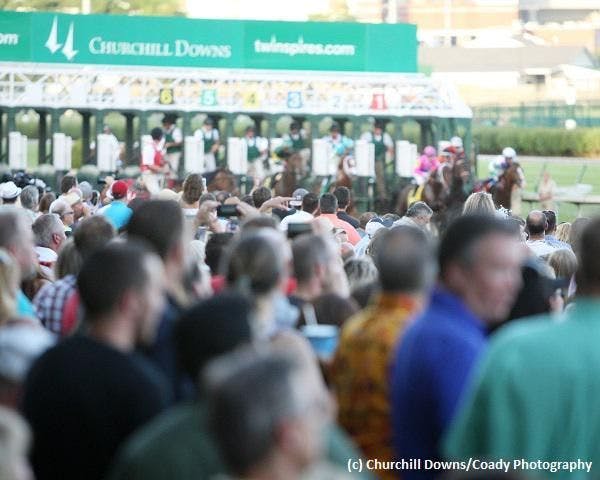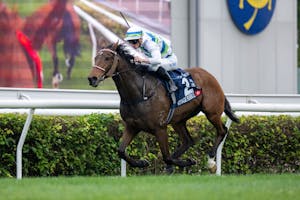Shapiro: Identifying Vulnerable Favorites Part 3

by Scott Shapiro
I am back again for another piece in my ongoing series on identifying vulnerable short priced horses.
After examining potentially over bet runners trying something for the initial time last week, the next two articles will focus on runners that have taken advantage of a race shape that fits them ideally in their last start, but face a more challenging set of circumstances in the upcoming event.
Horses that need the lead or a perfect trip upfront are often at the mercy of the other entries drawn for a given race. If the group they are set to compete against is void of early zip they can look like world-beaters. On the other hand, if the field is full of runners that like to be prominently placed, they tend to be forced to go much faster early or battle harder and look much more mortal.
Identifying Vulnerable Favorites Part 1
One of the better examples of this phenomenon is Grade 1-winning sprinter Masochistic.

The son of Sought After has compiled eight wins in 16 lifetime starts and earned more than $857,000, but has also burnt a lot of money at the windows in the starts when has failed to hit the wire first.
When the California-bred gelding is left alone on an uncontested lead or is confronted early under moderate fractions he is nearly unbeatable and looks like one of the best sprinters this decade. However, when he is forced to go quicker on the front end or duel early on with another fast rival he is as susceptible as they come.
A look back at Masochistic’s 2016 campaign illustrates the point. He was able to walk on the lead in two starts in the summer, including an effort that looks better on paper than it did in reality when beating a three-horse field in the Pat O’Brien (G2) at Del Mar.
He headed into the Breeders’ Cup Sprint off of 105 and 110 BRIS Speed ratings, which led to him going off as the 8-5 favorite against the country’s best sprinters.
However, savvy handicappers were able to determine that the veteran Ron Ellis trainee was going to have things much more difficult in the Grade 1 event than he had in his previous two tries.
Sure Masochistic ended up finishing a controversial second before being disqualified to seventh by the California Horse Racing Board, but trainer Bob Baffert’s Drefong was a logical alternative in the win pool and ended up returning a solid payout on top of $9.80 despite heading into the championships off of a four-race win streak.
Masochistic has continued to disappoint his backers in 2017, including a loss at 1-2 in the Triple Bend (G1) in March.
Identifying Vulnerable Favorites Part 2
Another runner that may not have commanded as much money as Masochistic over his career, but was a different animal when he had things his way early, is John Oxley’s Noble Bird.

The son of Birdstone has looked sensational at times when able to set his own fractions under no pressure, but when he has encountered a less than ideal race shape he became vulnerable as one of the top betting choices. The last three starts of his 2016 campaign demonstrate this.
The Mark Casse trainee came back off a disappointing performance in the Whitney (G1) at Saratoga in the summer and handled a field in the Lukas Classic Stakes at Churchill Downs before disposing of an eight-horse field in the Fayette (G2) at Keeneland at even money. Both races saw him make a clear early lead and pull away late under jockey Julien Leparoux.
After dominating two weaker groups void of early pace in Kentucky, the next logical step was the Clark Handicap (G1) in November, where Noble Bird met a group that had much more talent and early zip. He went off the 5-2 second choice to three-year-old Gun Runner, who left the gates as the 2-1 favorite.
One can argue that Noble Bird was unfortunate that day when he broke a step slowly, but his past performances support the fact that he never performed as well when race conditions were less than ideal and when he was taking on top competition.
Gun Runner won the Clark, paying just $6.20, but long shot Breaking Lucky ran second at 46-1 leading to huge payouts in the exotics if you were able to toss Noble Bird and find the right horses to pair with one of the other logical win candidates.
A look back through Noble Bird’s racing history shows a horse that was dominant when he had the right trip against the right competition, but also a horse that was vulnerable, often at a short price, when he did not. Sharp horseplayers likely discovered this and took advantage.
As I have stated in past articles, this angle will not always work, but over the long haul it can really lead you to solid scores in races where it does. When it does not, you get beat by a short-priced horse and move on.
ADVERTISEMENT


